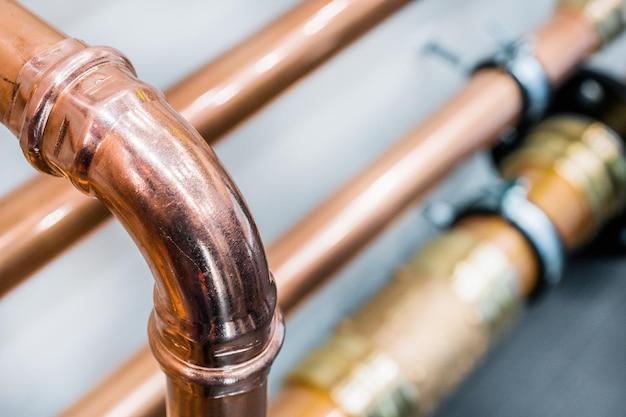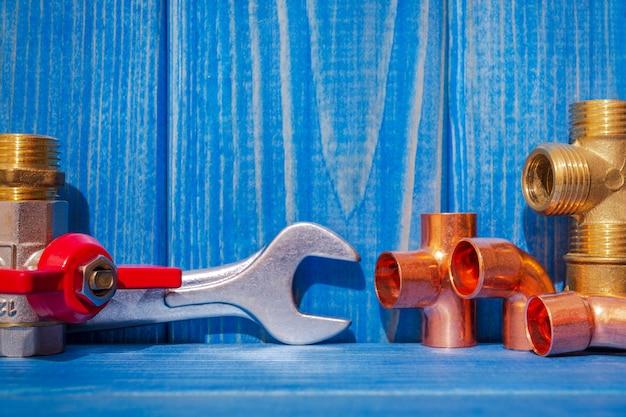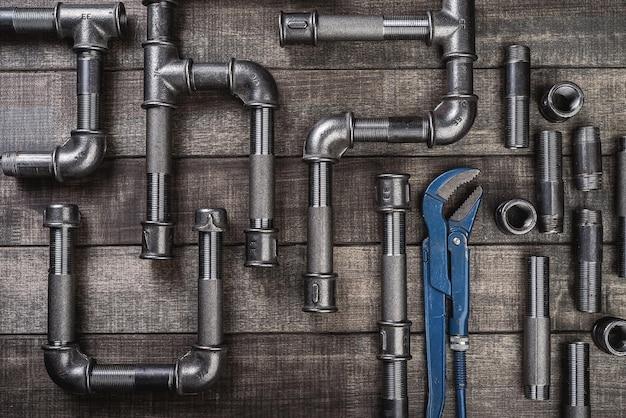Are you experiencing low water pressure, rust-colored water, or leaks? If so, it might be time to replace your plumbing pipes. Repiping your home with PEX (cross-linked polyethylene) pipes is an increasingly popular solution. But how much does it cost to repipe with PEX? Is it worth changing from copper to PEX? Can you do it yourself, or should you hire a professional? In this blog post, we’ll answer all these questions and more. We’ll also explore the various factors that affect the cost of repiping a house and the potential downsides of using PEX pipes. So, if you’re considering a repiping project, keep reading to find out everything you need to know!
Factors that Affect the Cost to Repipe with PEX
PEX is a popular material used for repiping homes. However, the cost to repipe with PEX may vary depending on several factors. Here are some of the factors that may affect the cost of repiping with PEX:
Size of the Home
The size of your home is one of the significant factors that determine the cost of repiping with PEX. The bigger the home, the more materials needed to complete the repiping process, the higher the cost.
Complexity of the Job
Another significant factor that can impact the cost of repiping with PEX is the complexity of the job. Homes with complicated plumbing systems may require more work and time to complete the repiping process, and this can increase the total cost of the project.
Type of PEX Used
The type of PEX used can significantly affect the cost of repiping with PEX. A cheaper type of PEX may save you some money, but it may not be as durable as a more expensive one. It is essential to consult a professional plumber to help you decide which type of PEX will work best for your home.
Labor Costs
The cost of labor can also impact the total cost of repiping with PEX. The hourly rate of professional plumbers may vary depending on your location, qualifications, and experience. It is advisable to get several quotes from different plumbers to compare prices and services offered.
Access to the Pipes
Access to the pipes is also an important factor that determines the cost of repiping with PEX. Homes with easily accessible pipes can save time and money, while those with hard-to-reach pipes may require more work, ultimately increasing the cost of the project.
In conclusion, several factors affect the cost to repipe with PEX. It is essential to seek professional advice to help you determine the best materials and labor costs that will fit your budget and meet your needs.
Cost to Repipe House
If you’re thinking about repiping your house, your budget is one of the first things to consider. Repiping can be a significant expense, so it’s important to know what factors impact the cost and how much you can expect to pay.
Material costs
The type of material you choose for your repiping project plays a significant role in the overall cost. PEX piping, for instance, is generally less expensive than copper piping. However, it’s important to consider the long-term cost benefits of each material. While copper is more expensive upfront, it lasts longer and requires less maintenance, which may save you money in the long run.
Labor costs
Another factor that affects the cost of repiping your house is the cost of labor. Labor costs vary depending on where you live, the complexity of the project, and the experience of the plumber you hire. It’s important to get multiple quotes from reputable contractors to ensure you get the best price for your project.
Size of the house
The size of your house also impacts the cost of repiping. A small house with fewer fixtures and pipes will generally cost less to repipe than a larger house with more fixtures and pipes. However, it’s important to note that every house is unique and your plumbing system may be more complex than you think.
Additional factors
There are other factors that can impact the cost of repiping your house, such as the age of your house and the condition of your pipes. If your pipes are severely damaged or in poor condition, it may be more expensive to repipe your house than if your pipes are still in good shape.
In conclusion, the cost to repipe your house varies depending on several factors, such as the material you choose, the size of your house, and the complexity of the project. It’s important to get multiple quotes and do your research to ensure you get the best price for your project. Keep in mind that investing in a quality plumbing system can save you money in the long run by reducing the need for repairs and maintenance.
House Repiping Cost Calculator
Are you curious about how much it would cost to repipe your house with PEX? You’ve come to the right place! We’ll guide you through the process of estimating your house repiping cost using a calculator.
Understanding Different Repiping Materials
Before we dive into calculating the cost to replace your pipes with PEX, let’s first understand the different repiping materials to choose from. Here are some commonly used materials for repiping:
-
Copper: durable, long-lasting
-
Galvanized steel: prone to rust and leaks, not recommended
-
CPVC: affordable, common in the US
-
PEX: flexible, cost-effective
How to Use a House Repiping Cost Calculator
To use a house repiping cost calculator, you’ll need to gather specific information about your home, including:
-
The total square footage of your home
-
The number of floors
-
The number of bathrooms and kitchens
-
The type of pipe material you want to use
Once you have this information, you can input it into the calculator, and it will provide you with an estimated cost to repipe your home.
Keep in mind that the cost to repipe your home will vary depending on the size of your home and the type of pipe material you choose. Therefore, it’s essential to have an accurate estimate of your home’s size and the number of bathrooms and kitchens.
Consider the Benefits of Repiping with PEX
Now that you’ve learned how to calculate the cost to repipe your home with PEX let’s consider the benefits of using this material.
PEX is flexible, easy to install, and cost-effective. It can also help improve water pressure and reduce the number of leaks in your plumbing system. Furthermore, PEX piping has a lifespan of up to 50 years, making it a perfect choice for homeowners who want to invest in a long-lasting plumbing system.
In conclusion, if you’re considering repiping your home, PEX is an excellent option. With the help of a house repiping cost calculator, you can estimate the cost of the project and plan accordingly.
Can I Repipe My Own House With PEX
If you’re looking to repipe your house, switching from traditional materials like copper or galvanized steel to PEX could be a great choice. But can you do it yourself?
Understanding PEX
PEX is a flexible material made from cross-linked polyethylene that’s straightforward to work with and easy to install. It’s also non-corrosive, durable, and has excellent resistance to high temperatures and pressure. Most importantly, PEX is significantly cheaper than copper or galvanized steel – saving you money.
Do-It-Yourself Repiping
Although PEX offers fantastic benefits, homeowners should consider some key factors before attempting a DIY repiping project. First, you need to assess the extent of the project and decide whether you can manage the work yourself or need to hire a professional. You may need to obtain a permit as well, depending on your local laws.
Secondly, you’ll need to purchase all the necessary materials and tools, such as PEX piping, fittings, crimp rings, and a crimping tool. While the overall cost of PEX is lower than alternative materials, it may still add up to a considerable sum.
Finally, you need to be comfortable with cutting pipes, soldering, and handling various tools. If you don’t feel confident doing the work yourself, it may be best to hire a professional. Otherwise, you might end up causing more damage or creating a safety hazard.
In summary, repiping your house with PEX can save you a lot of money in the long run. However, attempting to do the work yourself may require some technical know-how and a lot of tools. If you’re not entirely sure about taking on the project solo, it may be best to get an experienced professional to do the job properly.
Is it worth changing copper to PEX
If you’re considering repiping your home, you may be wondering whether it’s worth changing your copper pipes to PEX (cross-linked polyethylene). Here are some things to consider before making the switch:
The Advantages of PEX
PEX is a flexible material that is easy to install, making it a great option for repiping projects. It doesn’t require any soldering or special tools, which means that installation is faster and cheaper than with copper pipes.
PEX is also resistant to corrosion and scale buildup. It is less likely to develop leaks or bursts, which can lead to costly repairs and water damage in your home.
The Drawbacks of PEX
While PEX has a lot of advantages, there are also some disadvantages to consider. One of the main concerns is that PEX can be damaged by UV light. This means that it must be installed in a way that protects it from sunlight exposure.
PEX may also have a shorter lifespan than copper pipes. While copper pipes can last for decades, PEX pipes may only last for 20-25 years. This means that you may have to replace your PEX pipes sooner than you would have to replace copper pipes.
Cost Considerations
One of the main factors to consider when deciding whether to switch from copper to PEX is the cost. While PEX is generally cheaper to install than copper, there are some other costs to consider. For example, you may need to hire a professional plumber to install the PEX pipes, which can add to the overall cost of the project.
You should also consider the long-term costs of maintaining and replacing your pipes. While PEX may be cheaper to install, it may need to be replaced more frequently than copper pipes, which can add to the overall cost over time.
While there are advantages and disadvantages to both copper and PEX pipes, the decision to switch from copper to PEX ultimately depends on your specific needs and budget. If you’re looking for a cheaper, easier-to-install option that is resistant to corrosion and leaks, PEX may be a good choice. However, if you’re looking for a long-lasting, durable option that can last for decades, copper pipes may be the way to go.
Cost to Replumb a 1,500 Sq Ft House
Are you wondering how much it would cost to replace the old plumbing system in your 1,500 sq ft house with PEX? PEX, or cross-linked polyethylene, is a popular material used in plumbing due to its durability, flexibility, and resistance to corrosion. In this section, we’ll explore the cost of repiping a 1,500 sq ft house with PEX.
Factors Affecting the Cost
The cost to replumb a 1,500 sq ft house with PEX can vary depending on several factors. Some of the factors that can affect the cost include:
- The size and layout of the house
- The complexity of the plumbing system
- The accessibility of the plumbing system
- The quality of the PEX materials used
- The cost of labor in your area
Cost Estimate
On average, the cost to replumb a 1,500 sq ft house with PEX ranges from $4,000 to $10,000, including materials and labor costs. However, the cost can go up or down depending on the factors mentioned above.
If your house has a simple plumbing system and is easy to access, the cost can be on the lower end of the range. On the other hand, if your house has a complex plumbing system that is hard to access, the cost can be on the higher end of the range.
Saving Money
If you want to save money on the cost to replumb your 1,500 sq ft house with PEX, you can opt to do some of the work yourself. For instance, you can remove fixtures and appliances that are in the way of the plumbing system to make it easier for the plumber to access the pipes. Alternatively, you can purchase PEX materials and have them delivered to your house to avoid paying for markup costs.
In conclusion, the cost to replumb a 1,500 sq ft house with PEX can vary depending on several factors. However, on average, the cost ranges from $4,000 to $10,000, including materials and labor costs. By understanding the factors that can affect the cost, you can make an informed decision and save money where possible.
What are the disadvantages of using PEX plumbing
PEX plumbing has been increasingly popular in modern plumbing due to its impressive features and cheap cost. However, there are various reasons why some people prefer copper pipes over PEX pipes. In this subsection, we’ll discuss some of the downsides of installing PEX plumbing.
1. Shorter lifespan
PEX pipes are vulnerable to chemicals in the water and UV rays, which can result in early wear and degradation. The pipes can become brittle over time, leading to reduced water pressure and leaks. PEX may last for 20 to 25 years, but copper pipes can last up to 50 years or more.
2. Water Temperature
Although PEX pipes are designed to handle high water temperatures, prolonged exposure to hot water may cause them to deform or weaken. If you have a boiler or a high-temperature appliance, copper pipes might be a better option.
3. Not ideal for outdoor use
PEX pipes are not suitable for outdoor use as they quickly become brittle and crack or break due to UV rays, which can penetrate the pipes’ surface. Copper pipes are more durable and have better insulation than PEX pipes, making them an ideal choice for outdoor plumbing.
4. Susceptible to rodent damage
While copper is tough, PEX lacks the same durability, and rodents and other pests can easily gnaw through and damage them.
In conclusion, PEX pipes are an excellent choice for plumbing systems with their affordability and easy installation. However, they have some downsides, such as a shorter lifespan, unsuitability for outdoor use, and susceptibility to rodent damage. Moreover, they appear to be inferior to copper pipes in terms of durability, resistance to high temperatures and chemicals, and longevity.
How Much Does it Cost to Repipe a House in California
If you are living in California and you need to repipe your house, you may be wondering how much it will cost you. The cost to repipe a house in California will depend on various factors, including the size of your house, the type of piping you choose, and the labor costs. Here, we will explore the average cost to repipe a house in California.
Factors that Affect the Cost of Repiping a House in California
Several factors affect the overall cost of repiping a house in California. Here are some of the most significant factors that can increase or decrease the cost of repiping a house.
Type of Piping
The type of piping you choose will affect the cost of repiping your house. Although there are several piping materials available for repiping, including copper, PEX, and PVC, PEX is the most popular choice because it is affordable and easy to install.
Size of the House
The size of your house will also affect the cost of repiping. Generally, the larger your house, the more pipes you will need to replace, and the higher the cost of repiping will be.
Complexity of the Job
The complexity of the job will also affect the cost to repipe a house. For example, if the plumbing system in your house is old and inaccessible, the repiping job will be more complicated, which can increase the labor costs.
Average Cost of Repiping a House in California
The cost to repipe a house in California can range from $3,000 to $10,000 or more, depending on the factors discussed above. On average, the cost of repiping a house in California is around $5,000 to $6,000.
Repiping a house in California is a significant investment, but it is necessary to ensure a safe and reliable plumbing system in your house. Understanding the factors that affect the cost of repiping a house in California can help you budget for the project and choose the most cost-effective solution. Remember to get quotes from licensed and experienced plumbing contractors and choose the best option for your needs and budget.
How Much Does It Cost to Repipe with PEX
PEX piping is gaining popularity among homeowners as an affordable, durable, and easy-to-install plumbing system. But one question that many homeowners have is, “How much does it cost to repipe with PEX?” In this section, we’ll break down the costs associated with repiping your home with PEX.
Factors That Affect the Cost of Repiping with PEX
The cost of repiping with PEX varies depending on several factors, including the size of your home, the number of plumbing fixtures, and the complexity of the job. For example, a single-story home with one bathroom will be less expensive to repipe than a multi-story home with multiple bathrooms.
Additionally, the cost can be affected by the type of PEX you choose. PEX-A is the most expensive but has the highest flexibility and durability. PEX-B is less expensive but may be more prone to brittleness in cold temperatures. Finally, PEX-C is the least expensive but offers lower flexibility and is not recommended for use in outdoor applications.
Average Cost to Repipe with PEX
On average, homeowners can expect to pay between $2,000 and $6,000 to repipe their home with PEX. The total cost will depend on the factors mentioned above, as well as the specific plumbing contractor you choose.
It’s essential to obtain multiple quotes from several different plumbing contractors to compare prices and choose the best option for your budget and needs. Keep in mind that the cheapest option may not always be the best, as it can result in lower-quality work or materials.
Additional Costs
In addition to the cost of the actual PEX piping and labor, there may be additional costs associated with repiping your home with PEX. For example, if your plumbing system uses galvanized pipes, they will need to be removed before installation, which can add to the total cost.
Furthermore, if your home’s water pressure is too high, a pressure regulator may need to be installed to prevent damage to the PEX piping. This can also be an additional cost to consider.
In conclusion, the cost to repipe with PEX varies depending on several factors, but homeowners can generally expect to pay anywhere between $2,000 and $6,000. It’s essential to obtain multiple quotes from reputable plumbing contractors, compare prices, and choose the best option for your budget and needs. Additionally, be aware of any additional costs that may be associated with the installation to avoid any surprises during the process.
How Much Does It Cost to Repipe a 2000 Square Foot House
If you’re looking to repipe your 2000 square foot house, the cost can vary based on several factors. The main factors that affect the cost of repiping your home include the type of material you use and the complexity of the job. Let’s explore further:
Material Cost
The material cost usually constitutes the largest part of repiping your home. Most homes use copper pipes, but more and more homeowners are switching to PEX pipes. Copper pipes are more expensive but last longer, while PEX pipes are more cost-effective and easier to install. On average, the cost of repiping with copper pipes ranges from $2,500 to $15,000, while the cost of repiping with PEX pipes ranges from $1,500 to $8,000.
Complexity of the Job
The complexity of the job will also have an impact on the total cost of repiping your home. If the job requires more time and effort, the cost will increase. Factors that can increase complexity include the size of your home, the number of bathrooms and kitchens, whether you have a basement or crawl space, and the overall complexity of the existing plumbing system. On average, homeowners with larger homes and more complex plumbing systems can expect to pay more.
Total Cost Estimate
Overall, the cost to repipe a 2000 square foot house can range anywhere from $1,500 to $15,000, depending on the factors mentioned above. It’s best to get an estimate from a licensed plumber to get a more accurate cost for your specific situation.
In conclusion, repiping your home is a significant investment, but it can save you money in the long run by preventing leaks and reducing your water bill. Consider the material cost and complexity of the job when budgeting for this project.



